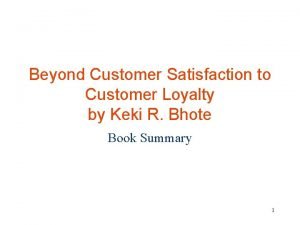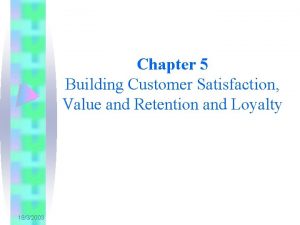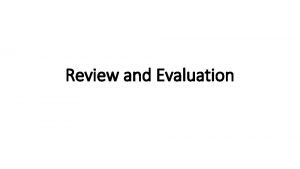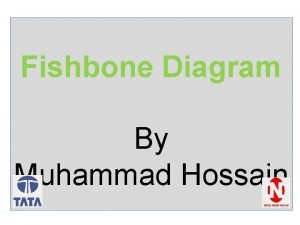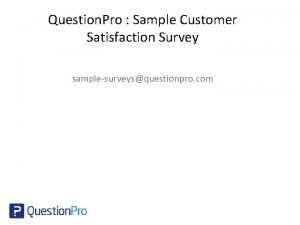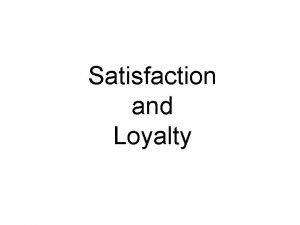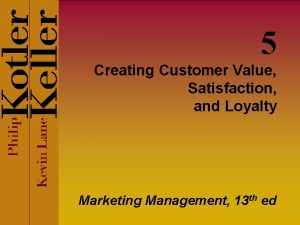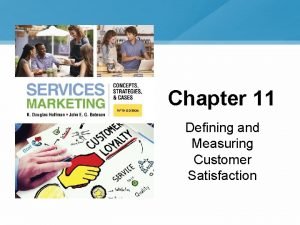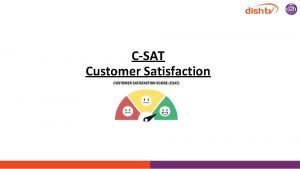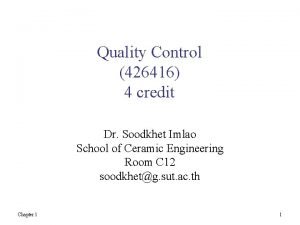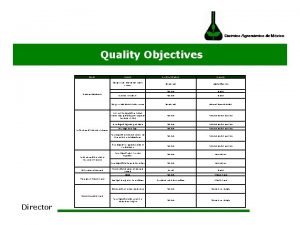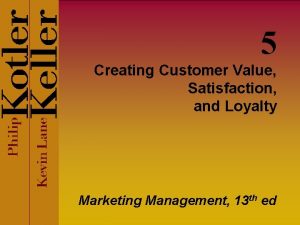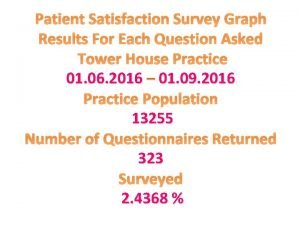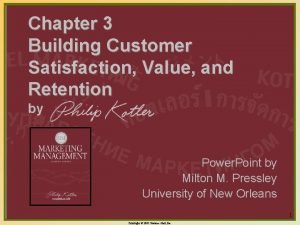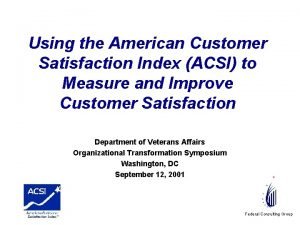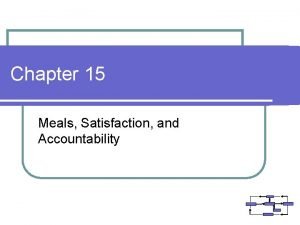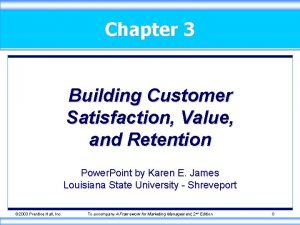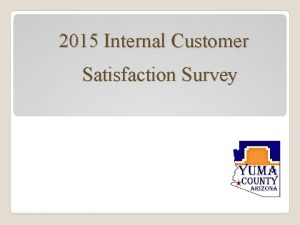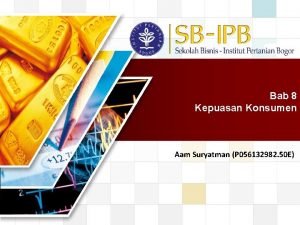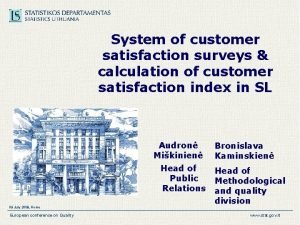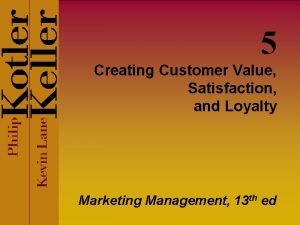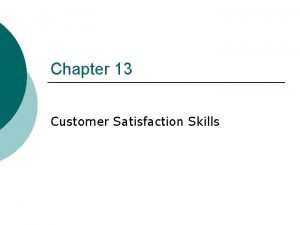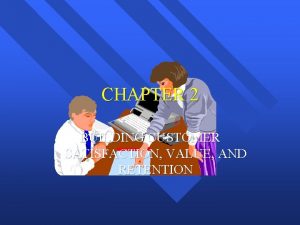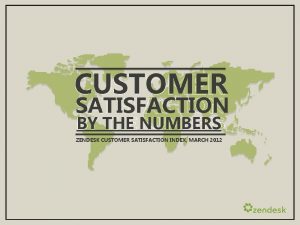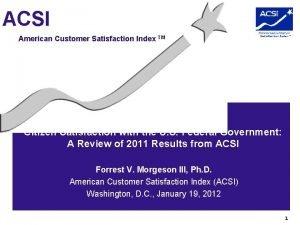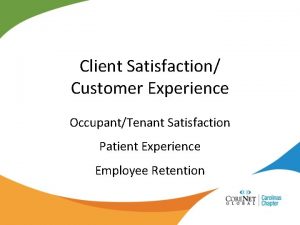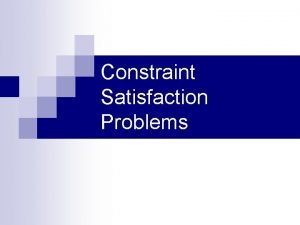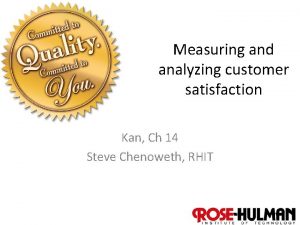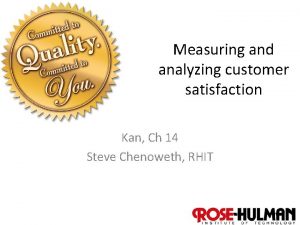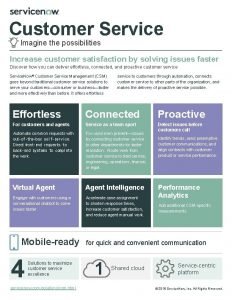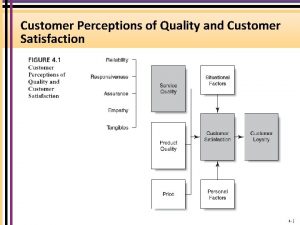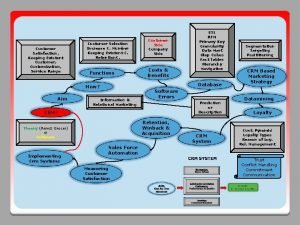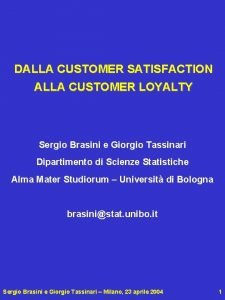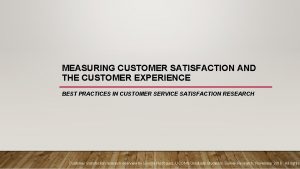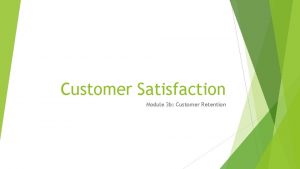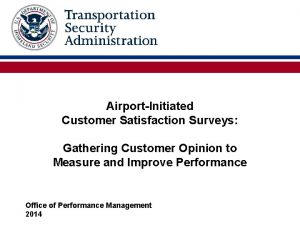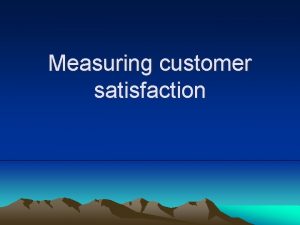Analyzing customer satisfaction Analyzing customer satisfaction Outline The






































- Slides: 38

Analyzing customer satisfaction

Analyzing customer satisfaction Outline § The psychology of customer satisfaction The concept of customer satisfaction □ Determinants of customer satisfaction and the expectancy-disconfirmation model of customer satisfaction □ § Designing a customer satisfaction survey § Measuring customer satisfaction and related concepts § Analyzing customer satisfaction

Analyzing customer satisfaction Learning goals § Understand what customer satisfaction means and why satisfying customers is important to marketers § Know what determines customer satisfaction according to the expectancy-disconfirmation model § Be familiar with both qualitative and quantitative approaches to measuring satisfaction § Know how to design a quantitative customer satisfaction study and measure satisfaction and its antecedents and consequences § Be able to analyze satisfaction data and conduct an importance-performance analysis

Analyzing customer satisfaction The concept of customer satisfaction/dissatisfaction § satisfaction refers to a customer’s judgment that a product or service (or its features) provided a pleasurable level of consumption-related fulfillment (Oliver 1997); § distinguish: transaction-specific satisfaction □ cumulative satisfaction □ § very high levels of customer satisfaction result in customer delight;

Analyzing customer satisfaction Satisfaction and loyalty (Heskett et al. ) Loyalty (retention) apostle 100% zone of affection 80% 60% zone of indifference 40% zone of defection 20% terrorist 0% satisfaction 1 2 3 4 5 extremely dissatisfied somewhat dissatisfied slightly dissatisfied very satisfied

Analyzing customer satisfaction A model of the satisfaction process: The expectancy-disconfirmation framework Past experience Advertising WOM expectations Other sources (dis-) confirmation Objective quality Other influences perceived performance satisfaction

Analyzing customer satisfaction Determinants of satisfaction § Expectations: anticipation of future consequences Will expectations: predicted product performance □ Should expectations: deserved product performance □ Ideal expectations: optimal product performance □ ideal should will

Analyzing customer satisfaction Determinants of satisfaction (cont’d) § Product performance: Perceptions of product performance or quality □ May differ from objective product quality □ § Disconfirmation: Comparison of product performance with prior expectations (gap judgment); □ Results in confirmation, positive disconfirmation, or negative disconfirmation □ Performance Positive disconfirmation Expectations

Analyzing customer satisfaction A model of the satisfaction process: The expectancy-disconfirmation framework Past experience Advertising WOM expectations Other sources (dis-) confirmation Objective quality Other influences perceived performance satisfaction

Analyzing customer satisfaction Assessing customer satisfaction § Various qualitative approaches exist Ghost shopping □ Complaint and suggestion systems □ Critical incident method □ § Here we will focus on quantitative approaches based on customer satisfaction surveys

Analyzing customer satisfaction The customer satisfaction survey process § Determine survey objectives (what’s the purpose of measuring satisfaction? ) Transaction vs. cumulative satisfaction □ Tracking satisfaction over time vs. process improvement □ Focus on satisfaction per se or the entire satisfaction process □ § Sampling of respondents (who should be asked? ) □ Current customers, former customers, prospective customers, competitors’ customers § Designing the questionnaire (what should be asked? ) Overall satisfaction vs. attribute satisfaction □ Antecedents and consequences of satisfaction □ Structure of the questionnaire □ § Analyze the data and implement the findings




Analyzing customer satisfaction Measuring satisfaction § At least one and preferably several overall satisfaction scales should be administered (e. g. , How satisfied are you with this brand? How satisfied were you with this visit to the restaurant? ); four or more response options should be provided (e. g. , very satisfied, dissatisfied, very dissatisfied); § To assess the emotional component of satisfaction, a terrible-delighted scale can be useful; § If process improvement is the goal, satisfaction with various components of the consumption and use experience will provide additional insights (unless performance and disconfirmation are assessed for specific attributes);

Analyzing customer satisfaction Measuring expectations § Question of which type of expectation is most relevant, or whether multiple expectations should be measured; § Examples: □ Medicine X will be easy/hard to swallow □ Medicine X should be easy/hard to swallow □ Ideally, medicine X would be easy/hard to swallow § Usually, expectations are not assessed prior to purchase, so customers are asked to reflect back to the situation prior to purchase and recall what they expected beforehand; § Expectations are important when performance is ambiguous and difficult to judge (wine, technical products);

Analyzing customer satisfaction Measuring perceived performance § Overall performance vs. attribute performance; § Attributes have to be satisfaction drivers rather than choice criteria; § Issue of specificity of attributes (tradeoff of length and managerial usefulness); § Measurement of beliefs, evaluations, and importance of attributes: Question whether beliefs (the extent to which a product delivers a certain benefit), evaluations, or both should be measured; □ Example: carbonation in a soft drink □ Importance ratings can be useful, but rating importance may be difficult for respondents; □

Analyzing customer satisfaction Measuring disconfirmation § During consumption, expectations can be confirmed or positively or negatively disconfirmed; § Disconfirmation (of the consumption experience overall or in terms of specific attributes) is usually rated on a much worse than expected-as expected- much better than expected scale; § Gaps could also be calculated based on the difference between performance and expectations, but subjective disconfirmation ratings usually work better; § Disconfirmation is salient when customers are involved and outcomes are unambiguous;

Analyzing customer satisfaction Summary of measures § I expected this product to be excellent-poor § This product has performed very well-very poorly § This product (or the performance of this product) has exceeded/met/fallen short of my expectations § I am satisfied/dissatisfied with the choice of this product § I intend to repurchase this product § I have complained to/complimented management about this product § I have told other people good (favorable)/bad (unfavorable) things about this product

Analyzing customer satisfaction Sequence of measurement § Overall measures first and then specific measures Halo effects □ Summary judgment based on overall impression □ § Specific measures first and then overall measures Primacy and recency effects □ Summary judgment based on attribute ratings □ § The measurement of expectations, performance, disconfirmation, and satisfaction should follow the logic implied by the expectancy-disconfirmation model; § If possible, consequences of satisfaction should be measured as well; § Include classification questions if subgroup analyses are to be conducted;

Analyzing customer satisfaction data § Summarize degree of satisfaction (overall and by subgroups) § Compare satisfaction (or performance) to some standard Expectations □ Ratings of competitors □ § Analyze determinants of satisfaction Overall satisfaction as a function of satisfaction with particular components of satisfaction □ Overall satisfaction as a function of expectations, perceived performance, and disconfirmation (overall or for particular attributes of the product) □ Importance-performance mapping □ § Analyze consequences of satisfaction □ Intentions, complaining/praising, WOM/recommendations

Analyzing customer satisfaction Using regression analysis to analyze satisfaction data §

Analyzing customer satisfaction Using regression analysis to analyze satisfaction data (cont’d) §

Analyzing customer satisfaction Example: Satisfaction with a restaurant as a function of food and atmosphere ID Satisfaction Food Atmosphere 1 4 4 5 2 5 4 6 3 4 4 3 4 5 6 3 5 3 4 2 6 5 4 2 7 5 4 4 8 3 4 5 9 4 4 3 10 3 4 5 Note: Only first 10 respondents are shown; total number of respondents is 200. Ratings are on a 1 -7 scale.

Analyzing customer satisfaction Analysis Toolpak -- Regression

Analyzing customer satisfaction Satisfaction example – Analysis Toolpak Regression Statistics Multiple R R Square 0. 66 0. 43 Adjusted R Square 0. 42 Standard Error 0. 79 Observations 200 ANOVA df SS MS F Significance F 2 197 199 92. 20 122. 00 214. 20 46. 10 0. 62 74. 44 0. 00 Coefficients 1. 35 Standard Error 0. 29 t Stat 4. 68 P-value 0. 00 Lower 95% 0. 78 Upper 95% 1. 93 Food 0. 66 0. 06 11. 31 0. 00 0. 54 0. 77 Atmosphere 0. 10 0. 05 1. 75 0. 08 -0. 01 0. 20 Regression Residual Total Intercept

Analyzing customer satisfaction

Analyzing customer satisfaction Satisfaction example – Enginius Model statistics Intercept Food Atmosphere Model statistics R-squared Adjusted R-squared Parameters 1. 355 0. 66 0. 10 Values 0. 43 0. 42 Standard deviations 0. 289 0. 06 0. 05 P-values 0. 000 0. 08

Analyzing customer satisfaction Assignment for next class § Exercises for satisfaction measurement: □ Envelopes. Satisfaction. Measurement. pdf □ Envelopes. Satisfaction. xlsx □ Pleasure. Boat. Satisfaction. Measurement. pdf □ Pleasure. Boat. Satisfaction. xlsx

Analyzing customer satisfaction Exercise 1: What determines satisfaction with personalized envelopes? § Do consumers’ pre-experience expectations influence their postexperience quality ratings? What are the managerial implications of your findings? § Do expectations and performance evaluations influence perceived disconfirmation as predicted by expectancy-disconfirmation theory? § Do expectations, performance, and disconfirmation influence ratings of satisfaction as predicted by expectancy-disconfirmation theory? Which variable is the strongest predictor of satisfaction? What are the implications of your findings for satisfaction management? § Does satisfaction influence future product purchase (choice)? § If you wanted to improve consumers’ satisfaction with First Class, which attributes should you focus on? [See the file Envelope. Satisfaction. Measurement. pdf for details on this assignment. ]

Analyzing customer satisfaction Analytis Toolpak – Descriptive statistics

Analyzing customer satisfaction A model of the satisfaction process: The expectancy-disconfirmation framework Past experience Advertising WOM + expectations - Other sources (dis-) confirmation + Objective quality Other influences perceived performance + + + satisfaction

Analyzing customer satisfaction Attributes of personalized envelopes § § § § Print quality (A 1) Paper quality (A 2) Letter clarity (A 3) Envelope style (A 4) Ink quality (A 5) Letter legibility (A 6) Overall quality (A 7)

Analyzing customer satisfaction Exercise 2: Importance-performance mapping for a luxury sport cruiser § How satisfied are customers with the company’s product? § What are the company’s strengths and weaknesses? Conduct an importance-performance analysis to answer this question. § What recommendations would you make to the management of this company in order to improve customer satisfaction? [See the file Pleasure. Boat. Satisfaction. Measurement. pdf for details on this assignment. ]

Analyzing customer satisfaction Importance-performance mapping Leverage Ignore Add resources Performance Status quo Importance

Analyzing customer satisfaction Consequences of satisfaction § Repurchase and repatronage intentions: Likelihood of (re)purchase □ Usually overstated and have to be adjusted □ § Complaining and praising □ Whether or not a customer complained, to whom, how many times, and why § WOM and recommendations □ How many other people a customers talked to, whether they mentioned mostly positive or negative things about the product, and whether they recommended that the other person buy or not buy a product;

Analyzing customer satisfaction American Customer Satisfaction Index (ACSI) market-based performance measure for firms, industries, economic sectors, and national economies; assessment of overall customer satisfaction as well as its antecedents and consequences; can be used for benchmarking over time and cross-sectionally;

Analyzing customer satisfaction
 Beyond customer satisfaction
Beyond customer satisfaction Building customer satisfaction value and retention
Building customer satisfaction value and retention Surveymonkey customer satisfaction
Surveymonkey customer satisfaction Iso12207
Iso12207 6m fishbone diagram template
6m fishbone diagram template Customer satisfaction survey
Customer satisfaction survey Loyalty spaarsysteem
Loyalty spaarsysteem Analyze customer satisfaction
Analyze customer satisfaction What are customer value satisfaction and loyalty
What are customer value satisfaction and loyalty Top-2-box customer satisfaction
Top-2-box customer satisfaction Creating customer value satisfaction and loyalty
Creating customer value satisfaction and loyalty Defining customer satisfaction
Defining customer satisfaction Dhoot wiring harness
Dhoot wiring harness Objectives of customer satisfaction
Objectives of customer satisfaction Kano model of customer satisfaction
Kano model of customer satisfaction Quality objectives for production department
Quality objectives for production department Creating customer value satisfaction and loyalty
Creating customer value satisfaction and loyalty Satisfaction graph
Satisfaction graph Customer satisfaction value and retention
Customer satisfaction value and retention Customer satisfaction index calculation excel
Customer satisfaction index calculation excel Low customer satisfaction fishbone diagram
Low customer satisfaction fishbone diagram A walk-through customer satisfaction audit
A walk-through customer satisfaction audit How to build customer satisfaction value and retention
How to build customer satisfaction value and retention Introduction of customer satisfaction
Introduction of customer satisfaction Scope of customer satisfaction
Scope of customer satisfaction Internal customer satisfaction surveys
Internal customer satisfaction surveys Logo kepuasan konsumen
Logo kepuasan konsumen Customer satisfaction index formula
Customer satisfaction index formula What is customer value satisfaction and loyalty
What is customer value satisfaction and loyalty Customer satisfaction in pharmaceutical industry
Customer satisfaction in pharmaceutical industry Customer satisfaction skills
Customer satisfaction skills Nmonetaryvalue
Nmonetaryvalue Example of topic outline and sentence outline
Example of topic outline and sentence outline Customer service training program outline
Customer service training program outline Các số nguyên tố
Các số nguyên tố đặc điểm cơ thể của người tối cổ
đặc điểm cơ thể của người tối cổ Các châu lục và đại dương trên thế giới
Các châu lục và đại dương trên thế giới Chụp tư thế worms-breton
Chụp tư thế worms-breton ưu thế lai là gì
ưu thế lai là gì
